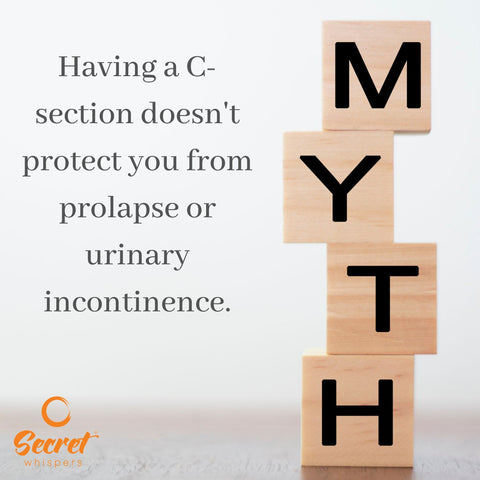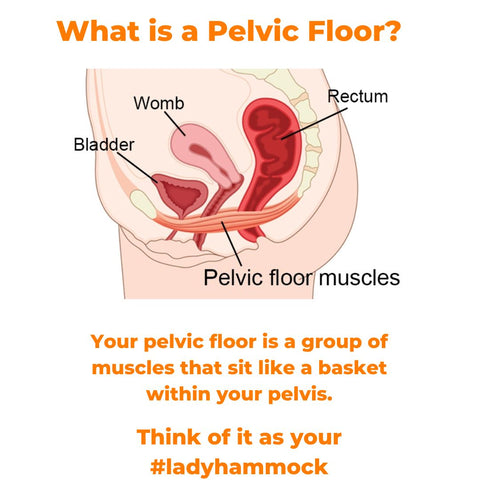The Ultimate Guide to Your Pelvic Floor After a C-Section
Women may need to have a caesarean section in order to deliver their babies safely for many different reasons. However, it is natural to wonder what effect a C-section has on your pelvic floor. In this article, we try to answer all the frequently asked questions about pelvic floors after a caesarean section.
Does a C-Section Affect Your Pelvic Floor?

The method of delivery has very little effect on pelvic floor issues. So, a C-section does not adversely affect your pelvic floor any more than a natural vagina delivery. It is more accurate to say that carrying a baby is a damaging factor to your pelvic floor, so no matter how you deliver, looking after and keeping your pelvic floor strong is paramount.
Studies show that by the time we reach 50, urinary incontinence rates are the same for mothers who had their children by caesarean or vaginal delivery. So, your Caesarean section will not have increased pelvic floor issues, but you will be just as prone to them as anyone who has carried a baby.
Do I Need to Do Pelvic Floor Exercises After C-Section?

Yes, absolutely, you need to do pelvic floor exercises after a C-section or, indeed, a vaginal delivery. However, you need to remember that C-sections are classed as major abdominal surgery, so you also need to take care of post-operative recovery instructions and not overdo anything.
The weight of your baby, your uterus and your own body weight during pregnancy weakens the pelvic floor by around 25%. Following the safe delivery of your baby, you will probably be told not to lift anything heavy and refrain from strenuous activity for about six weeks. However, luckily, pelvic floor exercises place no strain on the surgical incision and have no negative impact on your recovery. The only caveat for starting pelvic floor exercises after a C-section is that you wait until your catheter has been removed.
After a C-section, you do need to look out for urinary incontinence. Now it can be caused by a weak pelvic floor; however, in the period following C-section, it's important that you monitor for a urinary tract infection. Scar tissue, the placement or removal of your catheter, and not being able to empty your bladder completely could all cause minor complications post-operatively, but these can be easily rectified by your general practitioner. Just remember during the six-week recovery period not to assume that any pelvic incontinence is caused by a weak pelvic floor.
Pelvic Floor Exercises After C-Section
Are you looking to get started on your pelvic floor exercises after a c-section? You’re in the right place!
Exercise #1 - Just Breathe
Let's ease in gently with a breathing exercise that is perfect for new mothers. This is very cesarean-recovery safe and also perfect to help you relax. Belly breathing helps retrain your core muscles, which, unfortunately, are a casualty of a C-section. Laying on your back on your bed or so far, place your hands on your belly and try to relax. As you breathe in through your nose, feel your belly expanding into your hands. Push your breath through your mouth, pull your belly button towards your spine, and hold it for three seconds. Take ten breaths three times a day like this, and then ensure your breathing has returned to normal before you try and get up, as it could make you slightly dizzy.
Exercise #2 - Kegels

This is the easiest and most discreet way to exercise your pelvic floor and can be done anytime, anywhere. However, for the purposes of the exercise, we are focusing on sitting on a dining table-style chair towards the edge with your feet flat on the floor. Squeeze the muscles of your pelvic floor as if you were trying to stem the flow of urine and holding in wind. Hold onto this contracted feeling for around five seconds to start with, but over time, work up the length of the hold to 10 seconds. In your mind's eye, see the openings of your vagina, urethra and anus, all closing and lifting clear of the chair. Then relax your pelvic floor for 5 seconds and repeat this sequence 10 times. (You can also test your progress when you go to the toilet by actually trying to stem your urine flow midstream. However, only do very infrequently; otherwise, your bladder could refuse to empty correctly and lead to a urinary tract infection.)
We teach you how to do your Kegels correctly and how to incorporate into your every day daily routine. Click here to be notified when we are running the next 30 Day Pelvic Floor Challenge
or if you want to get started right now - you can purchase our 4 Week Pelvic Floor Workout Video Programme
Exercise #3 - Wall Sitting
This exercise is for a little bit later in recovery in case you fall over. Wait for your six-week check. If your doctor is happy that you are recovering well, then you can try this. Stand with your feet about 2 feet away from a wall. Lean backwards towards the wall as you lower your body into a seated position. You are looking to form a 90° angle with your hips and knees. This requires control of your core muscles, and you will need to engage them by sucking them into your belly button as you did with your belly breathing. You can also contract the pelvic floor at the same time for maximum impact. You should aim to hold this position for as long as possible and then rest for a couple of minutes before trying again. Remember, any pain to stop immediately. Every maternal body is different and recovery times are different too. Take it slowly.
In Closing
No matter how you deliver your baby, looking after your pelvic floor is vital. The good news is that it is never too late to start doing pelvic floor exercises, and pelvic floor toner products are available to help you ensure that you are getting the best from them. Following the activities above and using a pelvic floor toner can help you beat the pelvic floor issues that many mothers suffer in later life.
To learn more how our Pelvic Floor Exercise Weights work, head over here. Secret Whispers Pelvic Floor Training Weights
You can also join our fabulous womens only private Facebook Group
Fancy a FREEBIE? Download our FREE guide The easy way to get a stronger pelvic floor
Any questions? Just email us at support@secretwhispers.co.uk and we will get straight back to you.
Sources:
https://www.embracephysio.sg/c-section-and-pelvic-floor-muscle-recovery/
https://www.healthline.com/health/pregnancy/c-section-recovery-exercises










